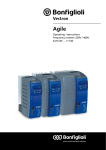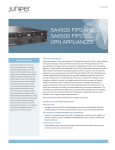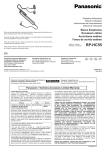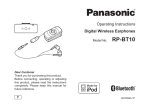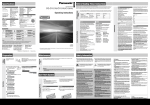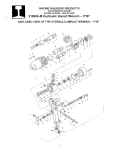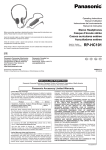Download Exile EX-1 Owner`s manual
Transcript
®
Model EX-1 Battery Keeper™
6/12V Battery Charger
Owner's Manual
~
BATTERY KEEPERtVr2 V8ATJBWCHARGij
fiDD
,..The information enclosed in this manual is to be used as a guide
to assist in the proper use of this product. This manual does not
cover every possibility, or use scenario.
Retro Manufacturing, LLC, Exile® or its subsidiaries, assume no
responsibility for any issues regarding the product's use or
misuse. Please read this manual thoroughly before use.
IMPORTANT SAFETY INSTRUCTIONS
SAVE THESE INSTRUCTIONS:
This manual contains important safety and operating instructions
for battery charger model: EX-1
EXILECHARGERS. COM
EX-1 Battery Charger Owner's Manual
Table of Contents
What's in the Box ........................................ 2.
Welcome ............................................... 3.
Warnings and Precautions ................................ 4.
Before You Charge Your Battery ........................... 8.
Connecting to the Battery. . . . . . . . . . . . . . . . . . . . . . . . . . . . . . . . 9.
Wiring Diagram ........................................... 10.
Wiring Diagram Overview .................................11.
Operating Instructions ................................... 12.
Troubleshooting ..........................................14.
Warranty ............................................... 15.
EX-1 Battery Charger Owner's Manual
What's in the Box
e1e1e
&ne
cr "
't :r IJ
BATTERY KEEPER3.5 AMP 6/12 Volt
EX-1
~attery
Charger
Red & Black battery clamps
w/ quick connect system
0-Ring terminals w/
quick connect system
Charger storage bag
EX-1 Battery Charger Owner's Manual
Welcome
Thank you for your purchase. The Exile® 6/12 Volt Battery Charger
combines simplicity of operation with premium features not found on
other battery chargers.
General Features
•
•
•
•
•
•
4-stage charging
Multiple battery compatible
Battery fault protection w/ audible alert
Reverse polarity protection w/ audible alert
IP65 dust/water-resistant
Maintains battery without over-charging
Notes
EX-1 Battery Charger Owner's Manual
Warnings and Precautions
WARNING
Risk of SERIOUS INJURY OR DEATH.
ELECTRICAL SHOCK, EXPLOSION, FIRE, AND EYE
INJURY HAZARDS.
PROTECT YOURSELF AND OTHERS.
Before use, READ AND UNDERSTAND Owner's Manual.
Failure to read and understand this information could result
in SERIOUS INJURY or DEATH.
DANGER
ELECTRICAL SHOCK HAZARD
1. This charger is an electrical device that can shock and
cause serious injury.
2. Do not cut power cords.
3. Do not submerge in water or get charger wet.
EXPLOSION HAZARD
4. Unmonitored, incompatible, or damaged batteries can
explode if used with charger.
5. Do not leave charger unattended while in use.
6. Do not attempt to charge damaged or frozen batteries.
7. Use charger only with batteries of recommended
voltage.
FIRE HAZARD
8. The battery charger is an electrical device that emits
heat and can burn.
9. Do not cover the charger
10. Do not smoke or use any other source of electrical
spark or fire when operating charger.
Keep the charger away from combustible materials.
EX-1 Battery Charger Owner's Manual
Warnings and Precautions(Continued)
1!\ WARNING 1!\
EYE INJURY HAZARD
1. Batteries can explode and cause flying debris.
2. Battery acid can cause eye irritation.
3. Wear eye protection when operating charger.
4. Avoid contact with eyes and wash hands after using
charger.
5. In case of eye contact, flush affected area with plenty
of water.
RISK OF EXPLOSIVE GASES
6. Working in vicinity of a lead-acid battery is dangerous.
Batteries generate explosive gases during normal battery
operation. For this reason-, it is of utmost importance that
you follow the instructions each time you use the charger.
7. To· reduce risk of battery explosion, follow these
instructions and those published by battery manufacturer
and manufacturer of any equipment intended to be used
in vicinity of battery. Review cautionary markings on
these products and on engine.
~CAUTION ~
1. Do not expose charger to rain or snow.
2. Use of an attachment not recommended or sold by the
battery charger manufacturer may result in a risk of fire,
electric shock, or injury to persons.
3. To reduce risk of damage to electric plug and cord,
pull by plug rather than cord when disconnecting
charger.
4. Do not operate charger with damaged cord or plug replace the cord or plug immediately.
5. Do not operate charger if it has received a sharp blow,
been dropped, or otherwise damaged in any way; take it
to a qualified serviceman.
6. Do not disassemble charger; take it to a qualified
serviceman when service or repair is required. Incorrect
reassembly may result in a risk of electric shock or fire.
7. To reduce risk of electric shock, unplug charger from
outlet before attempting any maintenance or cleaning.
Turning off controls will not reduce this risk.
EX-1 Battery Charger Owner's Manual
Warnings and Precautions (Continued)
IMPORTANT
DO NOT USE EXTENSION CORDS unless absolutely
necessary. Using an improper extension cord could result
in a risk of fire and electric shock and may result in
property damage, personal injury or death. If extension
cord must be used, make sure that:
1.) The pins on the extension cord plug have the same
number, size, and shape as those of the AC power cord
plug on the charger.
2.) The extension cord is properly wired and is in good
electrical condition.
3.) The wire size is as specified in the table below:
Length of cord in feet:
25
50
100 150
AWG size of cord:
18
18
16
14
USE THE FOLLOWING PRECAUTIONS WHEN YOU
WORK NEAR LEAD-ACID BATTERIES:
1. Consider having someone close enough by to come
to your aid when you work near a lead-acid battery.
2. Remove personal metal items such as rings,
bracelets, necklaces, and watches when working with a
lead-acid battery. A lead-acid battery can produce a
short-circuit current high enough to weld a ring or the
like to metal, causing a severe burn.
3. Use charger for charging a LEAD-ACID battery only. It
is not intended to supply power to a low voltage
electrical system other than in a starter-motor
application.
4. Do not use battery charger for charging dry-cell
batteries that are commonly used with home appliances.
These batteries may burst and cause injury to persons
and damage to property.
5. NEVER charge a frozen battery.
EX-1 Battery Charger Owner's Manual
Warnings and Precautions {Continued)
(Coninued) USE THE FOLLOWING PRECAUTIO NS
WHEN YOU WORK NEAR LEAD-ACID BATTERIES:
1. Have plenty of fresh water and soap nearby in case
battery acid contacts skin, clothing, or eyes.
2. Wear complete eye protection and protective
clothing. Avoid touching your eyes while working near
a battery. If battery acid contacts your skin or clothing,
wash immediately with soap and water. If acid enters
an eye, immediately flood the eye with running cold
water for at least ten (1 0) minutes and seek medical
attention as soon as possible.
3. Be extra cautious when handling metal tools
around a battery. If you drop a metal tool near a
battery it might spark or create a short circuit between
the battery terminals and some other metal part.
Either event may cause a dangerous electrical shock
hazard, a fire, or even an explosion, resulting in
property damage, personal injury, or death.
4. Never smoke or allow an open spark or flame in
the vicinity of the battery or engine.
IMPORTANT
1. Consider having someone close enough by to come to
your aid when you work near a lead-acid battery.
2. Remove personal metal items such as rings,
bracelets,necklaces, and watches when working with a
lead-acid battery. A lead-acid battery can produce a
short-circuit current high enough to weld a ring or the like
to metal,causing a severe burn.
3. Use charger for charging a LEAD-ACID battery only. It
is not intended to supply power to a low voltage electrical
system other than in a starter-motor application.
4. Do not use battery charger for charging
dry-cell batteries that are commonly used with home
appliances. These batteries may burst and cause injury
to persons and damage to property.
5. NEVER charge a frozen battery.
EX-1 Battery Charger Owner's Manual
Before You Charge Your Battery
PREPARING TO CHARGE THE BATTERY
1. If it is necessary to remove battery from vehicle to charge, always remove the
grounded terminal from battery first.
Make sure all accessories in the vehicle are off, so as not to cause an arc.
2. Be sure the area around battery is well ventilated while battery is being charged.
3. Clean battery terminals with a mixture of baking soda and hot water. Be careful to
keep corrosion from coming in contact with eyes.
4. Study all battery manufacturer's specific precautions such as removing or not
removing cell caps while charging and recommended rates of charge.
5. Determine voltage of battery by · referring to vehicle owner's manual and make sure
that output voltage.
6. If the battery is not a sealed battery, add distilled water to each cell (if necessary)
until the battery acid solution reaches the level specified by battery manufacturer. Do
not overfill. For a battery without cell caps, such as a valve regulated lead-acid battery
(VRLA), carefully follow the battery manufacturer's charging instructions.
7. Before charging, carefully read the battery manufacturer's specific precautions and
recommended rates of charge.
8. Determine the voltage of the battery by referring to the vehicle's owner's manual
and make sure that the charge mode is set at the correct voltage.
9. Co~nect and disconnect the DC output cables only after the battery charger is
placed in the STANDBY mode and the AC cord is removed from the electrical outlet.
NEVER allow the battery clamp or eyelet terminal connectors to touch each other.
BATTERY CHARGER PLACEMENT
1. Locate the battery charger as far away from the battery as possible.
2. Never place the battery charger directly above the battery; gases from battery will
corrode and damage battery charger.
3. When reading electrolyte specific gravity or filing battery, never allow battery acid to
come in contact with the battery charger.
4. Do not operate the battery charger in a closed-in area or an area with restricted
ventilation.
5. Do not set a battery on top of battery charger.
BATTERY SPECS
The following recommendations should ONLY be considered as guidelines. Always refer
to the battery manufacturer's recommendations for battery charging. The EX-1 is suitable
for charging all types of 6V &12V lead-acid & gel cell batteries, including Wet (Flooded),
Gel, MF (Maintenance-Free) and AGM (Absorption Glass Mat) batteries. The EX-1 is
suitable for charging batteries sized from 12-70Ah. The battery charger can also maintain
all battery sizes.
DC CONNECTION PRECAUTIONS
a) Connect and disconnect de output clips only after setting any charger switches to the
"off' position and remove ac cord from electric outlet. Never allow clips to touch each
other.
b) Attach clips to battery and chassis as indicated in as follow t he content of the page 9 .
EX-1 Battery Charger Owner's Manual
Connecting to the Battery
CONNECTING TO THE BATTERY
Before you connect to the battery, make sure that the AC power plug is not connected to
an electrical outlet. DO NOT CONNECT THE BATTERY CHARGER AC POWER PLUG
TO THE ELECTRICAL OUTLET UNTIL ALL OTHER CONNECTIONS ARE MADE. Make
sure you have identified the correct polarity of the battery terminals on the battery. The
POSITIVE battery terminal is typically marked by these letters or symbol (POS,P,+). The
NEGATIVE battery terminal is typically marked by these letters or symbol (NEG,N,-).
FOLLOW THESE STEPS WHEN BATTERY IS OUTSIDE VEHICLE. A SPARK NEAR
THE BATTERY MAY CAUSE BATTERY EXPLOSION. TO REDUCE RISK OF A SPARK
NEAR BATTERY:
1. Check polarity of battery posts. POSITIVE battery post usually has a larger diameter
than NEGATIVE post .
2. Attach at least a 24-inch-long 6-gauge (AWG) insulated battery cable to NEGATIVE
battery post.
3. Connect POSITIVE (RED) charger clip to POSITIVE post of battery.
4. Position yourself and free end of cable as far away from battery as possible - then
connect NEGATIVE (BLACK) charger clip to free end of cable.
5. Do not face battery when making final connection.
6. When disconnecting charger, always do so in reverse sequence of connecting
procedure and break first connection while as far away from batiery as practical.
7. A marine (boat) battery must be removed and charged on shore. To charge it on board
requires equipment specially designed for marine use.
FOLLOW THESE STEPS WHEN BATTERY IS INSTALLED IN VEHICLE. A SPARK
NEAR THE BATTERY MAY CAUSE BATTERY EXPLOSION. TO REDUCE RISK OF A
SPARK NEAR BATTERY:
1. Position AC and DC cords to reduce risk of damage by hood, door, or moving engine
part.
2. Stay clear of fan blades, belts, pulleys, and other parts that can cause injury to persons.
3. Check polarity of battery posts. POSITIVE battery post usually has larger diameter than
NEGATIVE post.
4. Determine which post of battery is grounded (connected) to the chassis. If negative post
is grounded to chassis (as in most vehicles), see (5). If positive post is grounded to the
chassis, see (6).
5. For negative-grounded vehicle, connect POSITIVE (RED) clip from battery charger to
POSITIVE ungrounded post of battery. Connect NEGATIVE (BLACK) clip to vehicle
chassis or engine block away from battery. Do not connect clip to carburetor, fuel lines, or
sheet-metal body parts. Connect to a heavy gage metal part of the frame or engine block.
6. For positive-grounded vehicle, connect NEGATIVE (BLACK) clip from battery charger
to NEGATIVE ungrounded post of battery. Connect POSITIVE (RED) clip to vehicle
chassis or engine block away from battery. Do not connect clip to carburetor, fuel lines, or
sheet-metal body parts. Connect to a heavy gage metal part of the frame or engine block.
7. When disconnecting charger, turn switches to off, disconnect ACcord, remove clip from
vehicle chassis, and then remove clip from battery terminal.
8. See operating instructions for length of charge information.
EX-1 Battery Charger Owner's Manual
Wiring Diagram
EX-1 Interface (detail)
These indicators light
up RED when selecting
the desired battery type
These indicators light (AGM (Gell Cell) or STD
up RED when selecting (Standard/Maintenance
Free) batteries
the 6V or 12V mode
When charging process
is started, this LED
indicator will light up
GREEN
Selects
between 6V or 12V
battery voltage
I
I
I
I
I
REVE
ULT
CHARGING
I
These LED indicators light upl
The POWER LED
The CHARGING LED
I
RED if reverse polarity is I (ORANGE) indicator
(YELLOW) indicator
I
sensed or if the charger sees allights up when the unit lights up when the unit I
I
problem "fault" with the
: is plugged into an AC
starts charging the
I
battery (too low of voltage, 1
outlet
battery
I
shorted, etc) Please note that 1
I
an audible alert will be heard 1
I
when the LED indicators light 1
I
I
up.
1
I
I
I
I
I
I
I
I
I
I
I
I
I
I
I
I
I
FULL
The FULL LED
(GREEN) indicator
lights up when the
battery charging
process is complete
EX-1 Battery Charger Owner's Manual
Wiring Diagram Overview
Quick Connect
Plugs
Included Red & Black Battery
Clamps, perfect for temporary
charging situations
Quick Connect
Plugs
Included 0-ring battery
terminals, perfect for
permanent charging situations
EX-1 Battery Charger Owner's Manual
Operating Instructions
00
00
12V
AGM
6V
••
REVERSE
0
FAULT
0
POWER
0
0
START
STD
CHARGING
0
FULL
0
Upon making a proper battery connection, plug the AC power cord into an AC
receptacle. All unit LEOs will light momentarily, then only the LEOs corresponding
to power ON and the default charging settings (12V, AGM) should stay lit. The
charger is now in Standby Mode. If the Reverse Polarity Indicator LED illuminates
along with and audible "beep", disconnect from AC power supply immediately
and determine the cause of the alarm.
00
12V
6V
1.
00
AGM
STD
2.
0
START
3.
Choose a battery voltage charge setting. The default setting is
the 12V mode, which will apply to most charging applications.
To charge in 6V mode, push the SELECT 1 button until the "6V"
LED is illuminated.
-
Choose a battery type setting. The default setting is AGM
(corresponding to AGM and Gel Cell style batteries). To
charge Standard and Maintenance Free acid batteries, push
SELECT 2 button until the "STD" LED is lit.
Press the "START" button, and both the "START" LED and
"CHARGING" LED will illuminate simultaneously.
Once the this process has started, the charger will automatically
begin and complete the charging process (Please note that the
length of charging time may vary depending on the charging
condition of the battery). Note: If the FAULT LED illuminates, and
an audible beep is heard, disconnect immediately from AC power
and determine the cause of the alarm.
When the charging process is complete, the "FULL" LED will illuminate.
This indicates that the initial charging cycle is complete and the charger is now in
Maintenance Mode, and will resume charging as needed to keep your battery in
optimal condition. When you are finished with the charging process, disconnect
AC power cord from AC outlet, then disconnect DC leads from vehicle ground and
battery in the reverse sequence of the connection procedure.
EX-1 Battery Charger Owner's Manual
Operating Instructions (Continued)
EX-1 Charging Steps {detail)
The Ex-1 battery charger features a 4 step charging process:
Step 1: Diagnostic Start Mode
Checks the battery voltage to make sure battery connections are good and the
battery is in a stable condition before beginning the charging process. Will start the
charging process with a gentle "soft" charge.
Step 2: Primary Charge
Continues the Primary charging process, charges battery to 90°/o capacity.
Step 3: Final Charge
Brings the charge level to 100°/o. Once this threshold is reached, the battery charger
will deliver small amounts of current to provide a safe, efficient charge and limit
battery gassing.
Step 4: Battery Maintain
Monitors the battery voltage continuously to determine if a maintenance charge
should be initiated. If the terminal voltage falls below approximately 6.4V {6V) and
12.8V {12V), the charger will start the Battery Maintain cycle until voltage reaches
approximately 7.2V {6V) and 14.4V {12V) and then will discontinue the charge cycle.
Maintain cycle is repeated indefinitely to keep the battery at full charge, without
overcharging. Once connected and in this mode, the battery charger can be left
connected indefinitely.
Input Voltage AC:
Working Voltage AC:
Input Current:
Efficiency:
Power:
Charging Voltage:
Charging Current:
Back Current Drain:
Charger Type:
Type of Batteries:
Battery Chemistries:
Battery Capacity:
Housing Protection:
Cooling:
Noise Level:
Dimensions {L x W x H):
Weight:
Approval:
120 VAC, 60Hz
110-130 VAC, 50-60Hz
1.2ARMS Max
82°/o Approx.
68W Max
7.2V/14.4V
3500mA
<5mA
4 Step, Fully Automatic, Switch-Mode
6V & 12V Lead-Acid
Wet, Gel, MF & AGM
12-70Ah, Maintains All Battery Sizes
IP65
Natural Convection
<50 dB
6.5 x 2.9 x 1.83 Inches
.53 Kg/1.17 Pounds
UL for US and Canada
EX-1 Battery Charger Owner's Manual
Troubleshooting
PROBLEM
POSSIBLE CAUSE
The battery's voltage is lower than 3 Volts
A few seconds after pressing
the START key, the FAULT
LED lights up continuously,
along with an audible alarm.
The battery's voltage is too high (above 15
Volts for 12 Volt batteries or higher than 7.5
Volts for 6 Volt batteries)
If the REVERSE LED starts
to blink continuously followed
by an audible alarm.
The battery could be defective
or at the end of it's life cycle.
Please note that after checking
the condition of the battery, the
charger will automatically switch
to "stand-by" mode.
There may be a short circuit in the battery or
in one of the cells in the battery.
You are attempting to charge a 12 Volt
battery with the battery charger set to the 6
Volt mode.
A few seconds after pressing
the START key, the
CHARGING LED blinks
continuously.
SOLUTION
Unplug the power supply lead
from the AC wall socket to
reset the charger. Plug back
into the AC socket. Then
follow the 1, 2 & 3 steps in the
Operating Instructions section
of this manual to start the
charging of the battery.
You are attempting to charge a 6 Volt battery
with the battery charger set to the 12 volt
mode.
Unplug the power supply lead
from the AC wall socket to
reset the charger. Plug back
into the AC socket. Then
follow the 1, 2 & 3 steps in the
Operating Instructions section
of this manual to start the
charging of the battery.
The battery charger is attempting to recover
an exhausted battery.
Unplug the power supply lead
from the AC wall socket to
reset the charger. Plug back
into the AC socket. Then
follow the 1, 2 & 3 steps in the
Operating Instructions section
of this manual to start the
charging of the battery. When
charging the battery, if the
CHARGING LED starts to
blink continuously, the
charger is attempting to
recover an exhausted battery.
Wait a few seconds, if the
FAULT LED lights up, this
means that the attempt to
recover the battery has failed
and you will need to replace
the battery.
The clamps or o-ring terminals of the
charger's output leads are not properly
connected to the battery terminals.
Unplug the power supply lead
from the AC wall socket,
inspect the clamp and a-ring's
current mounting position.
Correctly mount the clamps/arings and then plug the
charger back into the AC wall
socket to continue charging
the battery.
EX-1 Battery Charger Owner's Manual
Warranty
If your product does not work properly because of defects in materials and workmanship
Exile TM, a division of Retro Manufacturing, LLC (collectively referred to as "the warrantor")
will, for the length of 12 months (Parts & Labor), which starts with the date of original
purchase ("warranty period"), at its option either (a) repair your product with new or
refurbished parts, or (b) replace it with a new or refurbished product. The decision to repair
or replace will be made by the warrantor.
During the "Labor" warranty period, there will be no charge for labor. During the "Parts"
warranty period, there will be no charge for parts. You must mail in your product prepaid
during the warranty period. If batteries are included, they are not warranted. This warranty
only applies to products purchased and serviced in the United States, Alaska, Hawaii or
Puerto Rico. This warranty is extended only to the original purchaser of a new product
which was not sold "as is". A purchase receipt or other proof of the original purchase date
is required for warranty service.
To handle a warranty issue, contact us at [email protected] or 888-3251555 and get a Return Authorization number. All returns and warranty issues must
receive a Return Authorization (RA) number. Any product received without a RA number
will be refused.
LIMITED WARRANTY-LIMITS AND EXCLUSIONS
This warranty ONLY COVERS failures due to defects in materials and workmanship, and
DOES NOT COVER normal wear and tear or cosmetic damage. The ·warranty ALSO
DOES NOT COVER damages which occurred during shipment, failures which are caused
by products not supplied by the warrantor, failures which result from accident, misuse,
abuse, neglect, bug infestation, mishandling, misapplication, alteration, faulty installation,
set-up adjustment, maladjustment of consumer control, improper maintenance, improper
antenna, inadequate signal reception or pickup, power line surge, improper voltage supply,
lightning, modification, commercial use (such as use in hotels, offices, restaurants, or
other business uses) or rental use of the product, or service by anyone other than the
technician from the factory service center or other authorized service centers, or damage
that is attributable to acts of God.
THERE ARE NO EXPRESS WARRANTIES EXCEPT AS LISTED UNDER "LIMITED
WARRANTY". THE WARRANTOR IS NOT LIABLE FOR INCIDENTAL OR
CONSEQUENTIAL DAMAGES RESULTING FROM THE USE OF THIS PRODUCT, OR
ARISING OUT OF ANY BREACH OF THIS WARRANTY. (As examples, this excludes
damages for lost time, cost of having someone remove or re-install an installed unit if
applicable, travel to and from the sevicer, and loss of media, data or other memory
contents. The items listed are not exclusive, but are for illustration only.) ALL EXPRESS
AND IMPLIED WARRANTIES, INCLUDING THE WARRANTY OF MERCHANTABILITY,
ARE LIMITED TO THE PERIOD OF THE LIMITED WARRANTY.
Some states do not allow the exclusion or limitation of incidental or consequential
damages, or limitatio'ns on how long an implied warranty lasts, so the exclusions may not
apply to you. This warranty gives you specific legal rights and you may also have other
rights which vary from state to state. If a problem with this product develops during or after
the warranty period, you may contact your dealer or service center.
®
Model EX-1 Batter y KeeperTM
6/12V Batter y Charg er
Owne r's Manua l
EXILE OHAR GERS . COM
••
'
Cargador de batena
Exile ™ is a trademark of
Retro Manufacturing, LLC
























